Magento to Shopify Migration: The Most Detailed Guide
In this article, we’ll cover everything you need to know about Magento to Shopify migration, including:
- The benefits of migrating Magento to Shopify
- The steps involved in the process
Key Takeaways
- Store owners might consider migrating from Magento to Shopify for reasons such as reduced hosting and development costs, a desire for a more intuitive interface, or the need for a platform with less technical maintenance.
- Since Magento and Shopify have different theme structures, store designs are typically not directly transferable. Merchants often need to choose a new theme or customize one in Shopify.
- After migration, merchants should consider redirecting old URLs, re-establishing marketing integrations, and informing their customer base about the change.
Types of data to migrate from Magento to Shopify
If you manually migrate the data from Magento to Shopify, you can only export and import both product data and customer data.
However, if you are preparing for Magento to Shopify migration, you can export data and import data as follows:
- Product data: product names, descriptions, SKUs, prices, images, variants, and inventory levels from Magento to Shopify.
- Customer data: customer names, email addresses, phone numbers, shipping and billing addresses, and order history from Magento to Shopify.
- Orders: order numbers, customer information, product information, order status, and shipping details from Magento to Shopify.
- Categories and Collections: category names, descriptions, and images.
- Reviews and Ratings: the review content, rating, and author.
- CMS Pages: Title, created date, URL, description.
- Coupons
- Manufacturers
Which migration method is best for you?
Three methods to migrate Magento to Shopify
To transfer your data from Magento to Shopify, you can try one of these 3 methods:
- Automated migration using an importer app: Use an app from the Shopify App Store that migrates your Magento store data.
- Manual Migration: Export Magento data in CSV format and import it into Shopify using Shopify’s built-in import tool.
- Finding an Expert: Hire an expert who specializes in Magento to Shopify migration.

Magento to Shopify Replatforming: Which Method Should You Use?
The migration method you should use for Magento to Shopify replatforming depends on several factors, including the size of your store, the complexity of your data, and your budget.
You can manually transfer if:
- You are a small store with a simple product catalog and limited customer data.
- ou have a limited budget and want to avoid additional costs and don’t mind doing the technical work.
You can use an importer app if:
- You have a large store with complex product catalogs, multiple integrations, and extensive customer data.
- You want a quick and effective replatforming.
- You have quite a decent amount of money to spend on this migration.
You can hire a migration expert if:
- You have large stores or complex product catalogs where you want to ensure efficient and correct migration.
- You don’t want to spend time and effort on this migration and just want to delegate the task to the expert.
- You are willing to pay a large amount of money, as long as the result satisfies you.
Magento to Shopify migration: Checklist
Migrating from one e-commerce platform to another, like moving from Magento to Shopify, can seem daunting. However, with a proper checklist, this transition can be smoother. Here’s a brief analysis of what such a checklist might entail:
- Understand Why: Before diving in, understand why you’re migrating. Shopify might offer a more user-friendly interface, better mobile responsiveness, or a specific app integration that Magento doesn’t.
- Product & Customer Data: Migrating your product details, including descriptions, prices, and photos, is essential. Similarly, don’t forget to move customer details like addresses, purchase histories, and contacts.
- Backup Data: Always backup your Magento store data. This ensures you have a fallback option should anything go wrong during the migration.
- Inventory Assessment: List out all assets like products, customer data, order histories, and more. Knowing what needs to be migrated helps in planning and avoids leaving anything crucial behind.
- Theme and Design: Magento themes can’t be directly transferred to Shopify. Decide if you’ll adapt your current design or choose a new Shopify theme. Either way, this is a chance to refresh your store’s look.
- Product Migration: Move product details, images, SKUs, and prices. Tools and apps are available to automate this, but ensure data consistency post-migration.
- SEO Considerations: Keep an eye on your URLs. Changing URLs can affect SEO rankings. Use redirects if needed to ensure old URLs point to the appropriate pages on your new Shopify store.
- App and Extension Evaluation: Not all Magento extensions have direct counterparts in Shopify. Identify critical extensions and find Shopify apps that offer similar functionalities.
- Redirects: Ensure your Magento website links redirect correctly to your Shopify pages. This step helps in retaining your web traffic and search engine rank.
- Shipping Details: Set up your shipping preferences on Shopify. This encompasses shipping costs and delivery options.
- Payment Methods: Shopify might have different payment options than Magento. Research and choose the best payment methods suitable for your store.
- Testing: Before making your Shopify store public, test all data, features, and tools thoroughly. Review and transfer any third-party tools or apps from Magento. While direct matches might not exist on Shopify, search for apps with similar functions. If unsure, seeking advice from a Shopify expert can be beneficial. This will ensure your store operates without glitches and that the data migration from Magento to Shopify is accurate.
- Go Live: Once you’re satisfied with the testing, you can make your Shopify store live. Monitor for any issues that might arise in the initial days.
- Inform Customers: Keep your customers and subscribers in the loop about the platform shift. Share any pertinent updates and strategize your communication to guarantee a smooth shift for your community.
In short, migrating from Magento to Shopify can be a structured and hassle-free process with the right checklist. Preparation and testing are key to ensuring a successful transition.
Magento to Shopify migration: Before migration
Whatever method you use, you still have to prepare for the migration. Here are a few steps you need to take before you start migrating.
Step 1: Back up Your Magento Store
Here’s a step-by-step guide on how to back up your Magento store:
- Log in to your Magento Admin Panel.
- Navigate to the System menu and click on the Tools submenu.
- Select the Backup option from the list.
- On the Backup page, you will see several options: Database, Media, and System. Select the backup type that you want to perform.
- Select the backup destination. You can choose to save the backup file to your local computer or to a remote server via FTP or SFTP.
- Click on the Backup Now button to start the backup process.
Once the backup process is complete, you will receive a notification email with a link to download the backup file. Make sure to save this file in a safe and secure location.
Step 2: Build a new Shopify store
Before you can start the migration process, you need to have a Shopify account first. If you don’t have an account yet, you can start a free trial or purchase a subscription package on Shopify.
Start a free trial
Starting a free trial on Shopify is very easy and straightforward. There is no credit card required. All you need to do is follow these simple steps:
- Go to the Shopify website and click the “Start free trial” button at the top right corner of the page.
- Enter the required information. Note that you can always change the information later.
That’s all. As you finish registering, you will be redirected to your new Shopify store’s dashboard. Here, you can start customizing your new Shopify store and adding products.
Your free trial lasts for only 3 days.
Choose the right Shopify plan
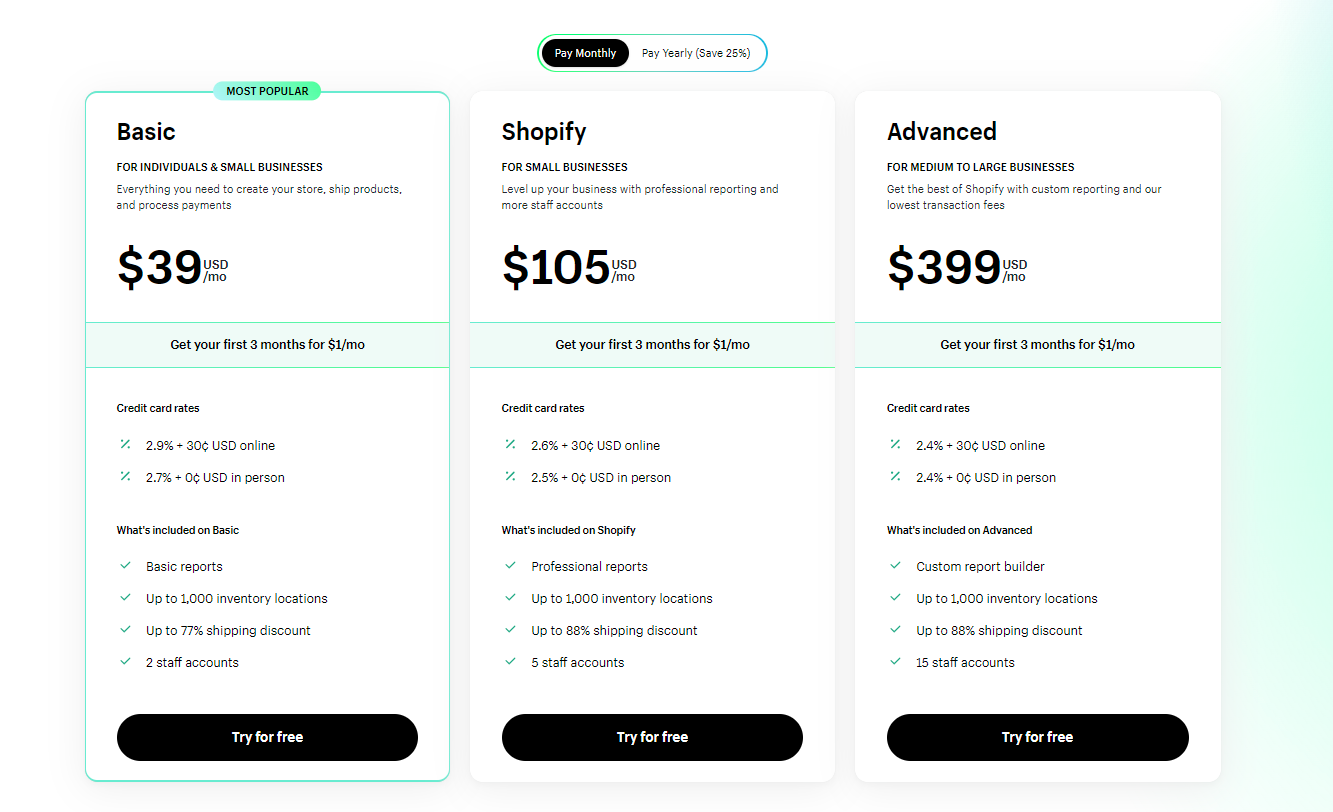
After a 3-day free trial, you’ll need to subscribe to a Shopify plan to use this platform. To choose the most suitable plan, consider your business needs and budget.
Shopify currently offers main different subscription plans on Shopify:
- Basic Shopify: If you’re just starting out with your online store, the Basic Shopify plan is a great option at $39 per month. This plan includes all the essentials you need to launch your new Shopify store, including a website, shopping cart, and blog.
- Shopify: As your business grows, consider the Shopify plan, which is priced at $105 per month. In addition to everything included in the Basic Shopify plan, this subscription offers more advanced features such as professional reports, gift cards, discount codes, and abandoned cart recovery.
- Advanced Shopify: Finally, for high-volume businesses, the Advanced Shopify plan offers the most advanced features for $399 per month. This plan includes everything in the Shopify plan, plus real-time carrier shipping, custom reports, and automated sales processes.
- Shopify Plus: This plan is designed for high-growth and high-volume businesses that require more advanced features, customization, and support. The pricing for this plan is tailored to each business’s needs, and it starts at $2,000 per month.
Note: You can always upgrade or downgrade your plan later on.
Step 3: Set up the basic information
Here are some of the details you’ll need to add:
- Store name
- Store address
- Contact information
- Payment and shipping settings: Set up your payment and shipping settings to ensure that customers can easily make purchases and receive their orders. You’ll need to choose a payment provider (such as Shopify Payments or PayPal) and set up your shipping rates and zones.
To set up these details, log in to your Shopify account and click on the “Settings” tab. From here, you can click on “General” to access the basic information settings. Be sure to fill out all of the required fields and double-check your information for accuracy.
Magento to Shopify migration: During migration
During the migration process, you need to use a migration app to help you migrate all the important data or manually export and import certain types of data, transfer your domain name to your new website, and create URL redirects.
Data transfer
Method 1: Automated migration using an importer app
Step 1: Sign up for a migration tool
There are several migration tools available for moving your store from Magento to Shopify, such as LitExtension, Cart2Cart, and more. Research the options and choose a migration tool that best suits your needs.
Migration apps may have different interfaces, yet the information most of them require is pretty similar: select the source and target carts, enter URLs, API, etc.
Step 2: Choose Magento as your source cart
In the migration setup process, you’ll need to:
- Select "Magento" as your source cart and provide your Magento store's URL.
- Install the Connector by downloading the Connector file, then unzip the downloaded file and paste the migration tool file to the root folder of your new Source store.
- Launch your FTP client (e.g., FileZilla, WinSCP, FileFTP, etc.) and provide your hostname, FTP login, and password.
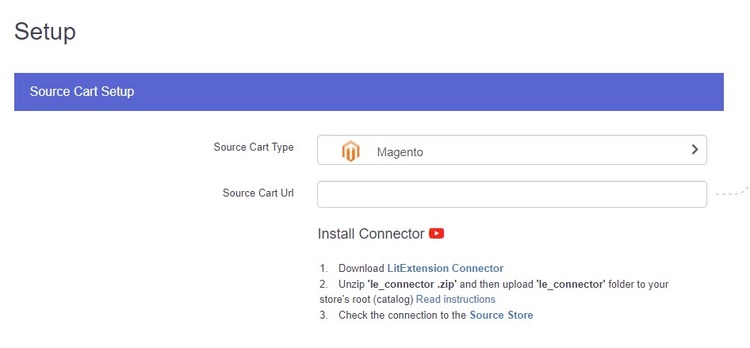
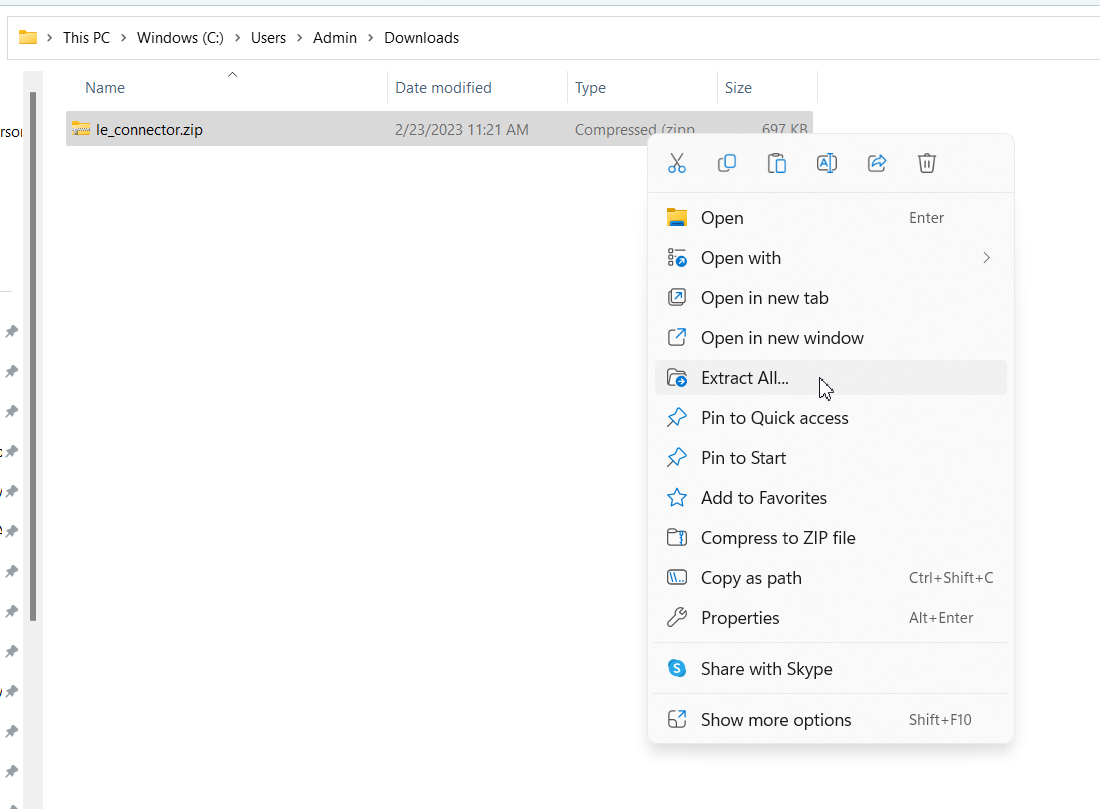

Step 3: Choose Shopify as your target cart
Next, you’ll need to:
- Select “Shopify” as your target cart.
- Provide your Shopify store URL and API password
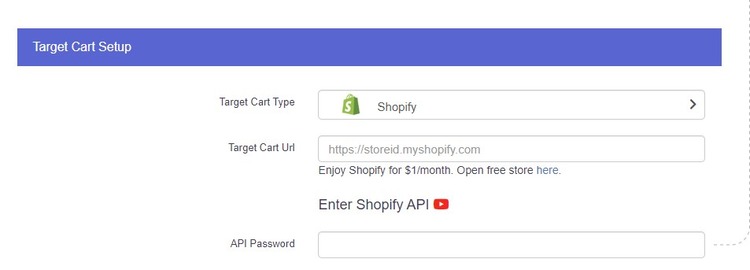
Step 4: Select the data to migrate
With both your Magento store and Shopify store connected to the importer app, you now need to select which data to migrate:
- Select the entities for your Magento to Shopify migration (products, customers, orders, manufacturers, reviews, etc.) - or tick the "Select all" box to migrate all the data.
- Choose any available migration extras that you want to use, such as the option to migrate source store categories into Shopify automated collections, use automated 301 redirects, or migrate categories and products' SEO URLs.
- Map the language and order status to display them correctly on your Shopify store.

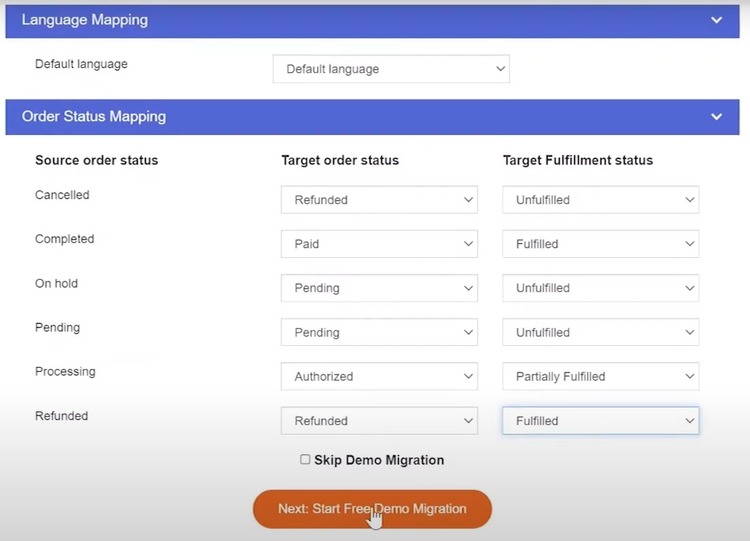
Step 5: Run the migration
Once you’ve configured the migration settings, you can start the Magento to Shopify migration process.
- Click "Start Demo Migration" to try the migration or "Skip Demo Migration" to perform a full migration immediately.
- Wait for the migration process to complete, and then check the results to ensure everything has been transferred correctly.
- Contact the importer app's technical support team if there are any issues to resolve.

By following these steps, you can successfully use an importer app to migrate your Magento store from your Shopify store.
Method 2: Manual Data Migration
For this Magento to Shopify migration method, you need to transfer data one type of data and one file at a time.
How to Migrate Product Data Manually
Step 1: Export Product Data from Magento
To migrate your product data from Magento to Shopify, you’ll need to export data from your Magento store.
- In your Magento admin panel, navigate to System > Export.
- Select "Products" as the entity type, and choose the CSV file format.


Step 2: Import Product Data into Shopify
- In your Shopify admin page, navigate to Products > Import.
- Browse or drag and drop the CSV file and upload the file.
- Click Upload and Continue > Next until it starts importing.

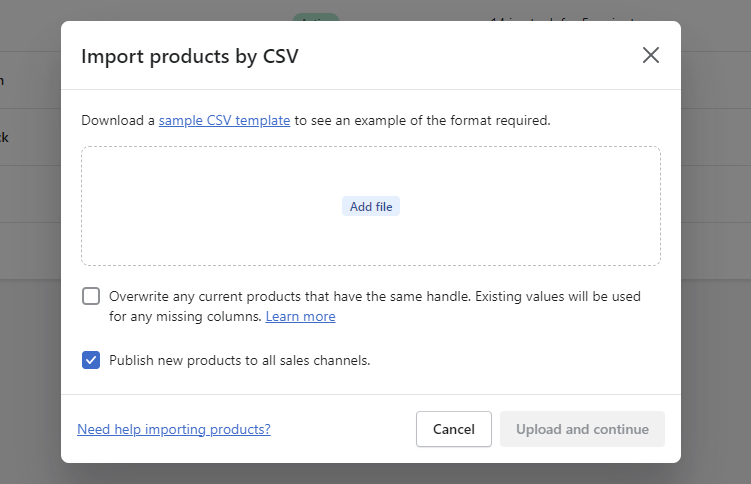
How to Migrate Customer Data Manually
Step 1: Export Customer Data from Magento
- In your Magento admin panel, navigate to System > Export.
- Select “Customers Main File” as the entity type, and choose the CSV file format.

Step 2: Import Customer Data into Shopify
- In your Shopify admin page, navigate to Customers > Import.
- Browse or drag and drop the CSV file and upload the file.
- Click Import Customers.
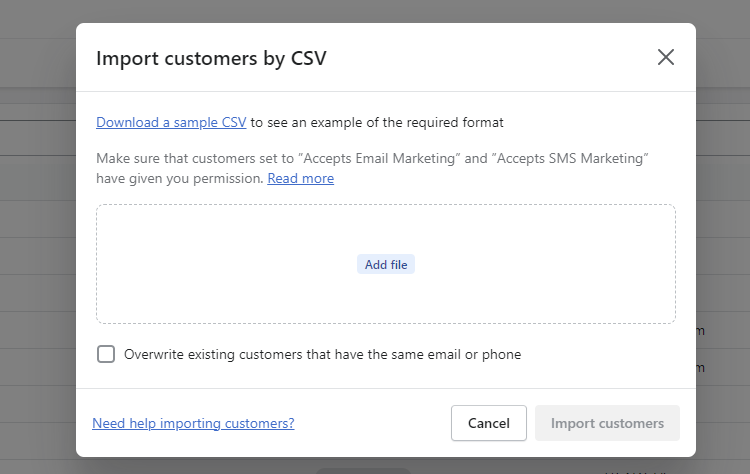
The same process—exporting from Magento and importing to Shopify—goes for all other types of data you can find:

Method 3: Hiring an expert
If you’re considering migrating your online store from Magento to Shopify with minimum effort, hiring an expert to handle the migration process for you can be a smart choice. With the help of a migration expert, you can ensure that all of your data is transferred accurately and securely without any loss or corruption.
Pros of hiring a migration expert
- Peace of mind knowing your migration is being handled by a professional
- Experience and knowledge to ensure a seamless and error-free transition
- Saves time and effort by handling the technical aspects of the migration process
- Frees up your time to focus on other important tasks
- Potential for faster and more efficient migration
Cons of hiring a migration expert
- Can be expensive, with costs varying based on complexity and amount of data transferred
- Risk of working with an unreliable or inexperienced migration expert
- May require additional time for research and vetting of potential experts
- Possibility of miscommunication or misunderstandings during the migration process
- Reliance on a third-party for critical business functions
Pricing for hiring a migration expert
The cost of hiring a migration expert can vary widely depending on a number of factors, including the size and complexity of your store, the amount of data that needs to be transferred, the level of customization required, and the level of the expert’s expertise. On average, you can expect to pay anywhere from a few to thousands of dollars for a complete migration from Magento to Shopify.
Where to find a migration expert
To find a reliable migration expert, you can also search for migration experts in:
- Freelance marketplaces such as Upwork, Fiverr, and others
- Shopify Experts Market
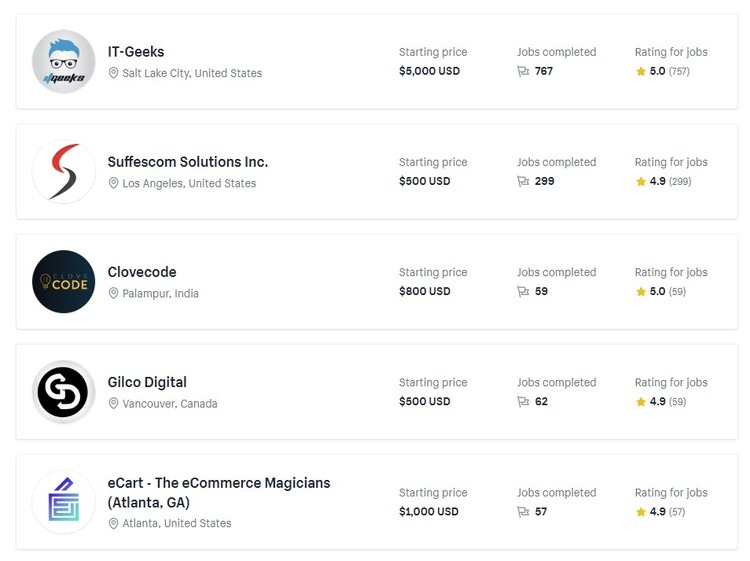
Domain transfer
After the Data transfer stage, here’s a detailed step-by-step guide on how to transfer a domain from Magento to Shopify. Keep in mind that the steps may differ depending on your domain provider, so use these instructions as a general guide.
- Log in to your domain provider account and find your DNS settings. This is usually located in a section called “Manage DNS.”
- Look for the “www” CNAME record and change it to point to “shops.myshopify.com.”
- Locate the “A Record” and change it to Shopify’s IP address. Some domain providers may require you to set a host name with the A record, so use the “@” symbol if needed.
- Confirm and save your changes.
- In your Shopify admin, go to “Settings” and then “Domains.”
- Click “Connect existing domain” and enter your custom domain.
- Click “Next” and then “Verify connection.” It may take up to 48 hours for the domain to connect.
- Once connected, set your custom domain as the primary domain to ensure customers see it when visiting your store.
- Click “Change primary domain” and select your custom domain.
- Save your changes.
Magento to Shopify migration: After migration
Step 1: Test Your Store
Before you officially launch your new store, it’s crucial to test it thoroughly to ensure that everything is working as it should. Here is the checklist for you to make sure everything is ready to go:
✅Review imported data
✅Test your website thoroughly to ensure all functionality and data are working properly
✅Customize your chosen Shopify theme to match your brand
✅Check your payment gateway and test it to ensure it's functioning properly
✅Check your shipping options, including rates, delivery times, and carriers
✅Launch your new Shopify website and start promoting it to your customers
Make sure your new Shopify store meets every point in this Magento to Shopify migration checklist.
Step 2: Train your staff
One crucial step after migration from Magento to Shopify is staff training. As the new platform might have different features and functionalities, it is essential to educate the staff about the changes and train them on how to navigate the new system. This includes teaching them how to add new products, manage orders, and handle customer support on Shopify.
You should:
- Provide detailed training to your staff about the new Shopify platform, including its features and functionalities. Ensure that your staff is well-versed in using Shopify’s backend tools to manage orders, track inventory, and fulfill shipments.
- Train your staff on how to use Shopify’s reporting and analytics tools to identify sales trends, customer behavior, and other valuable insights.
- Encourage your staff to promote the new platform to old customers by highlighting its benefits such as faster page load times, improved checkout experience, and a wider range of payment options.
- Provide your staff with guidelines and training on how to handle customer inquiries and complaints related to the migration from Magento to Shopify.
- Motivate your staff to learn and adapt to the new platform by offering incentives and rewards for achieving sales targets and customer satisfaction goals.
- Consider conducting regular training sessions to keep your staff updated on new Shopify features, best practices, and market trends.
Step 3: Inform your customers about the replatforming
One crucial step after migrating from Magento to Shopify is to promote your products to old customers and inform them about the replatforming. This will help to ensure that your loyal customers continue to buy from your online store. You can:
- Send an email newsletter to your existing customer base to inform them about the replatforming and the benefits of the new platform.
- Highlight the key features of Shopify and how it can improve their shopping experience.
- ffer a special discount or promotion to customers who make a purchase within a certain timeframe after the migration.
- hare updates on social media platforms, such as Facebook, Instagram, and Twitter, to reach a wider audience and engage with customers.
- ncourage customers to leave reviews on your new Shopify store to build social proof and attract new customers.
- rovide clear and concise instructions on how to create an account on Shopify, how to browse and purchase products, and how to contact customer support if needed.
- Offer a smooth transition for customers who have saved items in their Magento shopping carts by importing their data to Shopify.
- Provide ongoing support and assistance to customers who may have questions or concerns during the migration process.
Step 4: Launch Your Store
Once you have completed all the above steps, it’s time to launch your store officially.
How much to conduct Magento to Shopify migration?
The cost of migrating from Magento to Shopify depends on several factors, including your business size, specific needs, and budget. For larger businesses with intricate data, hiring an expert can be a good choice, with rates typically between $45 to $80 per hour. Alternatively, an automated database migration service might suit you better, usually priced around $200.
Here is the breakdown of the main types of costs required for the migration of Magento to Shopify:
Main costs of Magento to Shopify migration
Shopify subscription fees

Shopify offers three primary plans: Basic at $39/month, Shopify for $105/month, and Advanced at $399/month. Choosing an annual membership can lead to savings of up to 10%. There’s also a high-tier option, Shopify Plus, starting at $2000/month.
Themes and Applications
While Shopify provides free themes, premium ones are also available, ranging between $180 and $350. With over 6000+ apps, users can find both free and premium options. On average, many apps cost around $20/month.
Migration and Setup Costs
Migrating from Magento to Shopify can vary widely, from $500 to over $42,000 per project. Setting up a Shopify site may range between $100 and $27,000. Some experts might charge hourly, usually between $50 and $80. The costs largely hinge on your business niche, the site’s complexity, its size, and the expertise of the professionals you engage.
Factors determining the costs of Magento to Shopify migration
The cost to conduct a Magento to Shopify migration can vary widely based on several factors:
- Size and Complexity of the Store: A store with thousands of products, customers, and order histories will be more time-consuming and complex to migrate than a smaller store.
- Custom Functionality: If your Magento store has custom extensions or unique functionalities, these may need to be recreated on Shopify, either through available apps or custom development.
- Design: If you want to maintain the exact look and feel of your Magento store on Shopify, you might need a custom theme developed, which can be costly. Alternatively, you can opt for a pre-made Shopify theme and make minor adjustments, which is less expensive.
- SEO Considerations: Maintaining your SEO rankings might require additional efforts, such as setting up 301 redirects, which can add to the cost.
- Migration Tools or Services: While there are automated tools like LitExtension and Cart2Cart that offer migrations at a fixed price based on the number of entities (products, customers, orders, etc.), hiring a specialized agency or consultant might cost more but could ensure a smoother migration.
- Post-migration Testing and Tweaking: After migration, there might be a need for testing and making adjustments, which could incur additional costs.
- Using automated tools: Starting from $100 to several hundred dollars, depending on the number of entities and additional services chosen.
- Hiring an agency or consultant: Anywhere from $1,000 to $10,000 or even more, based on the complexity of the store and the services provided.
It’s essential to get a detailed quote from service providers or agencies after they assess your specific needs to understand the exact cost for your situation.
Magento to Shopify migration: Issues & Solutions

Here are some potential problems that you may encounter during the replatforming process and some suggested solutions to fix them:
Data Loss
One of the biggest potential problems during migration is data loss. It can happen due to various reasons, such as incomplete or incorrect data transfer, incorrect data mapping, or data corruption.
👉 To fix this problem: It’s essential to have a backup of your Magento data before starting the migration process. This way, if any data loss occurs, you can restore the backup and try again.
Broken Links
Broken links can occur due to the difference in URL structure between Magento and Shopify.
👉 To fix this problem: You need to set up URL redirects from the old URLs to the new ones. You can use Shopify’s built-in URL redirect tool or a third-party app to create 301 redirects.
Design and Functionality Issues
Replatforming can cause design and functionality issues, such as broken images, missing content, or non-functional features.
👉 To fix this problem: You need to test your new Shopify store thoroughly and make sure that everything is working correctly. You can also hire a Shopify expert to check your store for any design or functionality issues.
SEO Ranking Drop
Replatforming can also cause a drop in your SEO ranking if you don’t set up proper SEO redirects and metadata.
👉 To fix this problem: You need to set up 301 redirects for all of your old URLs and ensure that your metadata, such as title tags and descriptions, are optimized for SEO.
Integrations and Customizations
If you have customizations or integrations in your Magento store, they may not be compatible with Shopify.
👉 To fix this problem: You need to identify which integrations and customizations you need and find a suitable solution for Shopify. This can involve hiring a Shopify developer to create custom code or finding a third-party app that can handle your specific needs.
What to do with your old Magento store after you replatform to a new Shopify store?
After replatforming to a new Shopify store, you may be wondering what to do with your old Magento store. Here are a few options to consider:
- Shut down the old store: If you have no use for the old Magento store, you can shut it down completely. This involves canceling your hosting plan and deleting your website files. This option is suitable if you don’t plan to use Magento in the future and want to avoid paying for unnecessary hosting costs.
- Keep the old store running: If you have existing customers or content on your old Magento store that you want to maintain, you can keep the store running. However, it’s essential to redirect all of your old URLs to your new Shopify store to avoid any SEO penalties. You can also add a notice on your old store homepage informing visitors that you’ve moved to a new store.
- Archive the old store: If you want to keep your old store accessible but don’t want to maintain it actively, you can archive it. This involves downloading a backup of your store files and storing them on your computer or a cloud storage service. This option is suitable if you want to access your old store’s content or data in the future but don’t want to pay for hosting costs.
Tips for smooth Magento to Shopify migration
Setting Up 301 Redirects
When moving from Magento to Shopify, it’s vital to use 301 redirects. This ensures that search engines and visitors will be directed to the correct URLs, preventing “Page Not Found” or “404 Error” messages.
Transferring Blog Content
Your blog posts enhance organic traffic. Ensure these are shifted to Shopify in a way that remains relevant for users and search engines. Since Shopify doesn’t allow direct import of blogs and pages, you’ll need a third-party app from the Shopify App Store to help.
Finding Compatible Apps

Shopify offers over 8,000 apps to enhance your store’s features. Many differ from your Magento apps. After migration, check the Shopify App Store for similar apps.
Moving Customer Data
Transfer all customer data to Shopify. Export your Magento customer data into a CSV file, then upload it to Shopify. Note that customer passwords won’t move to Shopify due to encryption.
Review After Migration
- Visit the ‘Products’ section in Shopify to check if all product details, tags, and variants are in place.
- Click on ‘Customers’ to ensure successful data transfer.
Training Your Internal Team
Ensure your team is familiar with the new Shopify system to avoid operational issues. Organize training sessions for everyone who will use the platform. Getting them involved early in the migration process can also be beneficial.
How to choose an appropriate Magento to Shopify migration app
Here are the criteria you should consider when selecting a Magento to Shopify migration app:
- Data migration options. Choose a Magento to Shopify migration app that can migrate all the data you need from Magento to Shopify, including products, customers, orders, and other relevant data. The tool should allow you to easily export and import data without any loss or damage.
- User-friendly interface. The migration app should have a user-friendly interface that makes it easy to use and navigate. It should have clear and simple instructions for setup and use and should not require advanced technical knowledge to operate.
- Support for large volumes of data. Your Magento to Shopify migration app should be able to handle large volumes of data, including a large number of products, customers, and orders. The tool should be able to migrate all your data without any issues or data loss.
- Automated data mapping. The migration app should automatically map the data from Magento to Shopify. This will save you time and effort and ensure that all your data is migrated correctly.
- Data validation. The migration app should perform data validation to ensure that all the data migrated from Magento to Shopify is accurate and complete. It should detect and flag any errors or inconsistencies in the data and provide recommendations for fixing them.
- Technical support. Choose a Magento to Shopify migration app that provides good technical support. The tool should offer timely and helpful support to help you with any issues or questions you may have during the migration process.
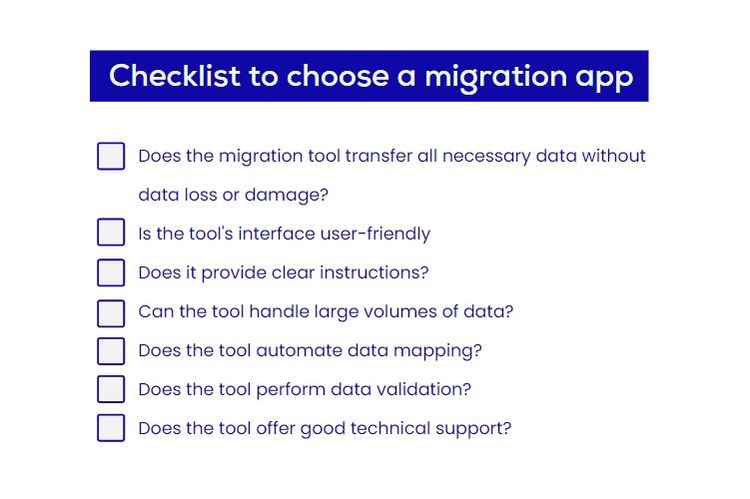
Top 3 Magento to Shopify migration paid apps
There are many Magento to Shopify migration apps on the Shopify App Store. However, here we recommend the most popular apps in the market today.
LitExtension
LitExtension is a popular data migration app that supports a wide range of platforms, including Magento and Shopify. It offers fast and reliable data migration services, including products, customers, orders, and more. LitExtension provides a user-friendly interface that makes it easy for non-techies to export and import data. It is a paid app with transparent pricing, and it offers excellent customer support.
Cart2Cart
Cart2Cart is another popular data migration app that supports a wide range of platforms, including Magento and Shopify. It offers an automated migration service that can transfer your data quickly and efficiently. Cart2Cart provides a range of customization options, including selecting what data to migrate, and it offers a free demo migration. It is a paid app with competitive pricing.
HulkApps
HulkApps is a comprehensive data migration app that supports a range of platforms, including Magento and Shopify. It offers a range of migration services, including products, customers, orders, and more. HulkApps provides a range of customization options for tailored migration, and it offers excellent customer support. It is a paid app with transparent and competitive pricing.
Why Migrate from Magento to Shopify?
While Magento is a great platform, you may find it no longer suitable for your business, and Shopify could be a better option. The reason could be because:
- Shopify is more user-friendly and easy to use compared to Magento, making it an ideal option for small businesses or those without technical expertise.
- Shopify offers a wide range of contemporary and responsive themes, including free options, which can save businesses time and money on design and development costs. Theme options on Magento are more limited.
- Shopify has a larger and more diverse selection of apps and integrations, providing businesses with more options to customize their online store and streamline their operations.
- Shopify offers 24/7 customer support through multiple channels, including phone and chat support, email, forum, and help center support, which can help businesses resolve issues quickly and efficiently.
- Shopify’s pricing is more affordable compared to Magento, especially when considering development, hosting, and maintenance costs.
- Shopify is an all-in-one solution that includes web hosting, SSL certificates, and a subdomain, which can simplify the setup process and reduce the need for technical expertise.
Overall, migrating from Magento to Shopify can provide businesses with a more user-friendly, customizable, and cost-effective e-commerce solution, enabling them to focus on growing their business rather than managing technical complexities.
Conclusion
That’s all you need to know about how to migrate from Magento to Shopify. Migrating your online store from Magento to Shopify can be a great way to improve your sales performance and reach a wider audience. By following the steps we’ve outlined, you can ensure a successful migration and take advantage of all the features and benefits that Shopify has to offer. So, if you’re ready to make the switch, start planning your Magento to Shopify migration today.





